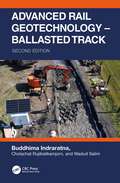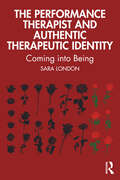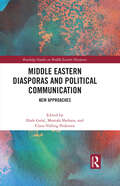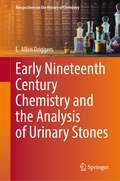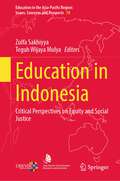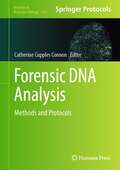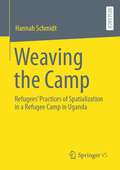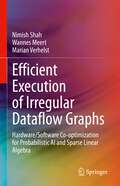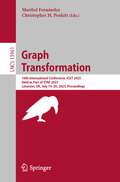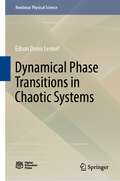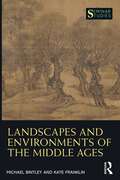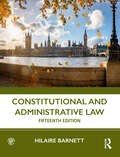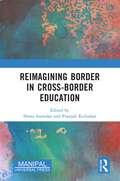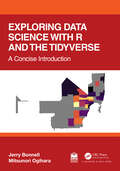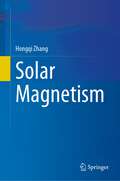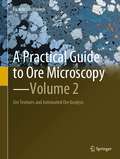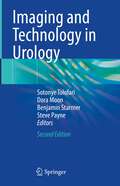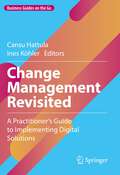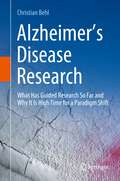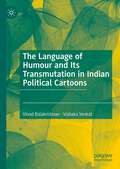- Table View
- List View
Advanced Rail Geotechnology – Ballasted Track
by Buddhima Indraratna Cholachat Rujikiatkamjorn Wadud SalimBallast plays a vital role in transmitting and distributing the train wheel loads to the underlying track substructure. The load-bearing capacity, safe train speed, and the levels of noise and vibration, as well as passenger comfort depend on the behaviour of ballast through particle interlocking and the corresponding deformation of this granular assembly. Attrition and breakage of ballast occur progressively under heavy and continual cyclic loading, causing track deterioration and rail misalignment affecting safety, while exacerbating the intensity of track maintenance. In the absence of realistic computational models, the track substructure is traditionally designed using mostly empirical approaches. In this book, the authors present the detailed information on the strength, deformation, and degradation aspects of fresh and recycled ballast under monotonic, cyclic, and impact loading using innovative geotechnical testing devices. A constitutive model for ballast incorporating particle breakage is presented representing a more realistic stress–strain response. The mathematical formulations and numerical models are validated using controlled experimental simulations and fully instrumented field trials. Revised ballast gradation is described to provide greater track resiliency and extended longevity. The book also provides a detailed description of geosynthetics for substructure improvement considering track deterioration caused by particle degradation, fouling, and impeded drainage. New to this second edition are extensive discussions on subgrade soil stabilisation, causes and mechanisms of soil fluidisation (mud pumping) under cyclic loading, and preventive and remedial measures to alleviate undue instability of ballast tracks. This book should prove most beneficial for final-year civil engineering students and for postgraduate teaching and learning. It is an ideal supplement for practising railway engineers and researchers engaged in the challenging tasks of future track design for heavier and faster trains.
Advanced Rail Geotechnology – Ballasted Track
by Buddhima Indraratna Cholachat Rujikiatkamjorn Wadud SalimBallast plays a vital role in transmitting and distributing the train wheel loads to the underlying track substructure. The load-bearing capacity, safe train speed, and the levels of noise and vibration, as well as passenger comfort depend on the behaviour of ballast through particle interlocking and the corresponding deformation of this granular assembly. Attrition and breakage of ballast occur progressively under heavy and continual cyclic loading, causing track deterioration and rail misalignment affecting safety, while exacerbating the intensity of track maintenance. In the absence of realistic computational models, the track substructure is traditionally designed using mostly empirical approaches. In this book, the authors present the detailed information on the strength, deformation, and degradation aspects of fresh and recycled ballast under monotonic, cyclic, and impact loading using innovative geotechnical testing devices. A constitutive model for ballast incorporating particle breakage is presented representing a more realistic stress–strain response. The mathematical formulations and numerical models are validated using controlled experimental simulations and fully instrumented field trials. Revised ballast gradation is described to provide greater track resiliency and extended longevity. The book also provides a detailed description of geosynthetics for substructure improvement considering track deterioration caused by particle degradation, fouling, and impeded drainage. New to this second edition are extensive discussions on subgrade soil stabilisation, causes and mechanisms of soil fluidisation (mud pumping) under cyclic loading, and preventive and remedial measures to alleviate undue instability of ballast tracks. This book should prove most beneficial for final-year civil engineering students and for postgraduate teaching and learning. It is an ideal supplement for practising railway engineers and researchers engaged in the challenging tasks of future track design for heavier and faster trains.
The Performance Therapist and Authentic Therapeutic Identity: Coming into Being
by Sara LondonExploring what it means to be an authentic therapist in the present day, Sara London playfully melds together the tenets of performance art and psychoanalytic theory to advance the hopeful new notion of the performance therapist. In an era where the therapist is now more of a public-facing entity than ever before, developing a sense of who one is both inside and outside of the consulting room is a complex undertaking. In response, London reconceptualises the therapist’s identity in a contemporary way, transcending preconceived labels, by bringing an understanding of performance art into an analysis of psychotherapeutic practice. Through this interdisciplinary approach, London attends to the complex questions faced by psychoanalysts and psychotherapists in training and in practice: can a therapist perform and be authentic? Can a therapist perform and have true intimate relationships within the confines of that performance? And can a therapist perform as themselves? This provocative and highly original work will provide both new and experienced psychotherapists with an understanding of the clinical and philosophical significance of performance art to cultivating therapeutic identity.
Middle Eastern Diasporas and Political Communication: New Approaches (Routledge Studies on Middle Eastern Diasporas)
by Ehab Galal Mostafa Shehata Claus Valling PedersenThis edited book explores the development and reconfiguration of Middle Eastern diasporic communities in the West in the context of increased political turmoil, civil war, new authoritarianism, and severe constraints on media in the Middle East. Taking an interdisciplinary approach, incorporating political and intercultural communication, the contributors investigate the rationale for diasporic politics, as well as the role of the transnational media in shaping diasporic political mobilization. This analysis of the media, situated within specific case studies, encompassing Afghani, Armenian, Bahraini, Egyptian, Lebanese, Syrian, Tunisian, and Turkish diasporic communities, reveals the variegated ways it influences diasporic politics and facilitates political action, as well as its influence on democratic actors residing in the Middle East. These new insights into Middle Eastern diasporas, political communication, and political mobilization are based on developments in the Middle East since 2011, and ultimately highlight how diaspora groups in the West relate to the situation in the Middle East, particularly in their countries of origin. The book is important reading for students and researchers working in political/intercultural communication and diasporic politics, as well as those with a general interest in the Middle East.
Early Nineteenth Century Chemistry and the Analysis of Urinary Stones (Perspectives on the History of Chemistry)
by E. Allen DriggersThis book tells the story of how chemists, physicians, and surgeons attempted to end the problem of urinary stones. From the late eighteenth to the early nineteenth centuries, chemists wanted to understand why the body formed urinary, pancreatic, and other bodily stones. Chemical analysis was an exciting new means of understanding these stones and researchers hoped of possibly preventing their formation entirely. Physicians and surgeons also hoped that, with improved chemical analysis, they would eventually identify substances that would reduce the size of stones, leading to their easier removal from the body. Urinary stones and other stones of the body caused the boundaries of surgery, chemistry, and medicine to blur. The problem of the stone was transformational and spurred collaboration between chemistry and medicine. Some radical physicians in America and Britain combined this nascent medical advancement with older disciplines, like humoral theory. Chemists, surgeons, and physicians in Charleston, Philadelphia, and London focused on the stones of the body. Chemical societies and museums also involved themselves in the problem of the stone. Meanwhile, institutions in Charleston, Philadelphia, and London served as repositories of specimens for testing and study as previously disparate practitioners and disciplines worked toward the comprehensive knowledge that could, perhaps, end suffering from stones. The primary audience of this book is historically-minded chemists, surgeons, physicians, and museum professionals.
Education in Indonesia: Critical Perspectives on Equity and Social Justice (Education in the Asia-Pacific Region: Issues, Concerns and Prospects #70)
by Zulfa Sakhiyya Teguh Wijaya MulyaThis book offers a critical analysis on Indonesian education by drawing from various critical perspectives and theoretical frameworks to explore persistent challenges and social inequality problems in the education sector. Critical perspectives are important to reveal how education is not a neutral, mechanistic process of cultivating the knowledge and skills of future generation. Instead, it is a battleground in which competing visions, ideologies, discourses, religious values, and political interests struggle for dominance in a given society. In each of the sections, contributors draw upon specific case studies and employ critical theories to analyze power relations or to identify and destabilize underlying structures, dominant discourses, hegemonic knowledge, policies, or practices. Some authors also highlight data evidencing inequities, inequalities, or injustices in Indonesian education system. As a handbook, the emphasis on critical perspectives is useful to identify and evaluate the ‘blind spots’ of dominant policy discourses and their pedagogical consequences. The plurality of critical approaches also means that this book is necessarily multidisciplinary. A unique feature of this book is the fact that most authors are Indonesian academics who bring with them tacit knowledge of practices and issues. Overall, this book enriches the literature by bringing together different disciplinary perspectives such as political science, psychology, international relations, economics, and linguistics to critically examine important issues related to education in Indonesia.
Forensic DNA Analysis: Methods and Protocols (Methods in Molecular Biology #2685)
by Catherine Cupples ConnonThis volume focuses on the latest techniques used in forensic DNA analysis. The chapters include a comprehensive collection of extraction, quantification, STR amplification, and detection methods for routine forensic samples, including manual, semi-automated, and automated procedures using both home-brew and commercial products. The chapters also discuss probabilistic modeling software and specialized start-to-finish procedures for mitochondrial DNA analysis, archived latent fingerprints, latent DNA, rapid DNA profiling, and next-generation sequencing. Written in the highly successful Methods in Molecular Biology series format, chapters include introduction to their respective topics, lists of the necessary materials and reagents, step-by-step, readily reproducible laboratory protocols, and tips on troubleshooting and avoiding known pitfalls.Cutting-edge and practical, Forensic DNA Analysis: Methods and Protocols is a valuable resource for researchers interested in learning more about forensic DNA analysis procedures.
Weaving the Camp: Refugees' Practices of Spatialization in a Refugee Camp in Uganda
by Hannah SchmidtThis book offers a socio-spatial analysis of a refugee camp in southwestern Uganda. Based on qualitative research with a multi-method approach the author shows how refugees are central actors in the operation and becoming of a camp. Not only do they crucially contribute to its social, micro-economic, and material realization but they also incrementally rearrange the camp space by acts of constant adaptation in order to make it work for its inhabitants. By means of social interaction, infrastructuring, translation, movement and material improvisation they navigate daily life in the semi-constricted and highly precarious space of the refugee protection regime and carve out its social and material landscape. Thus, this study challenges static understandings of camps and restricted conditions and puts forward theoretical implications for the rethinking and reassessment of agency in such contexts by calling for closer attention to ordinary practices.
Efficient Execution of Irregular Dataflow Graphs: Hardware/Software Co-optimization for Probabilistic AI and Sparse Linear Algebra
by Nimish Shah Wannes Meert Marian VerhelstThis book focuses on the acceleration of emerging irregular sparse workloads, posed by novel artificial intelligent (AI) models and sparse linear algebra. Specifically, the book outlines several co-optimized hardware-software solutions for a highly promising class of emerging sparse AI models called Probabilistic Circuit (PC) and a similar sparse matrix workload for triangular linear systems (SpTRSV). The authors describe optimizations for the entire stack, targeting applications, compilation, hardware architecture and silicon implementation, resulting in orders of magnitude higher performance and energy-efficiency compared to the existing state-of-the-art solutions. Thus, this book provides important building blocks for the upcoming generation of edge AI platforms.
Graph Transformation: 16th International Conference, ICGT 2023, Held as Part of STAF 2023, Leicester, UK, July 19–20, 2023, Proceedings (Lecture Notes in Computer Science #13961)
by Maribel Fernández Christopher M. PoskittThis book constitutes the refereed proceedings of the 16th International Conference on Graph Transformation, ICGT 2023, held as Part of STAF 2023 in Leicester, UK, in July 2023. The 14 full papers and 2 short papers presented in this book were carefully reviewed and selected from 29 submissions. The conference focuses on describing new unpublished contributions in the theory and applications of graph transformation as well as tool presentation papers that demonstrate main new features and functionalities of graph-based tools.
Dynamical Phase Transitions in Chaotic Systems (Nonlinear Physical Science)
by Edson Denis LeonelThis book discusses some scaling properties and characterizes two-phase transitions for chaotic dynamics in nonlinear systems described by mappings. The chaotic dynamics is determined by the unpredictability of the time evolution of two very close initial conditions in the phase space. It yields in an exponential divergence from each other as time passes. The chaotic diffusion is investigated, leading to a scaling invariance, a characteristic of a continuous phase transition. Two different types of transitions are considered in the book. One of them considers a transition from integrability to non-integrability observed in a two-dimensional, nonlinear, and area-preserving mapping, hence a conservative dynamics, in the variables action and angle. The other transition considers too the dynamics given by the use of nonlinear mappings and describes a suppression of the unlimited chaotic diffusion for a dissipative standard mapping and an equivalent transition in the suppression of Fermi acceleration in time-dependent billiards. This book allows the readers to understand some of the applicability of scaling theory to phase transitions and other critical dynamics commonly observed in nonlinear systems. That includes a transition from integrability to non-integrability and a transition from limited to unlimited diffusion, and that may also be applied to diffusion in energy, hence in Fermi acceleration. The latter is a hot topic investigated in billiard dynamics that led to many important publications in the last few years. It is a good reference book for senior- or graduate-level students or researchers in dynamical systems and control engineering, mathematics, physics, mechanical and electrical engineering.
The Performance Therapist and Authentic Therapeutic Identity: Coming into Being
by Sara LondonExploring what it means to be an authentic therapist in the present day, Sara London playfully melds together the tenets of performance art and psychoanalytic theory to advance the hopeful new notion of the performance therapist. In an era where the therapist is now more of a public-facing entity than ever before, developing a sense of who one is both inside and outside of the consulting room is a complex undertaking. In response, London reconceptualises the therapist’s identity in a contemporary way, transcending preconceived labels, by bringing an understanding of performance art into an analysis of psychotherapeutic practice. Through this interdisciplinary approach, London attends to the complex questions faced by psychoanalysts and psychotherapists in training and in practice: can a therapist perform and be authentic? Can a therapist perform and have true intimate relationships within the confines of that performance? And can a therapist perform as themselves? This provocative and highly original work will provide both new and experienced psychotherapists with an understanding of the clinical and philosophical significance of performance art to cultivating therapeutic identity.
Middle Eastern Diasporas and Political Communication: New Approaches (Routledge Studies on Middle Eastern Diasporas)
by Ehab Galal Mostafa Shehata Claus Valling PedersenThis edited book explores the development and reconfiguration of Middle Eastern diasporic communities in the West in the context of increased political turmoil, civil war, new authoritarianism, and severe constraints on media in the Middle East. Taking an interdisciplinary approach, incorporating political and intercultural communication, the contributors investigate the rationale for diasporic politics, as well as the role of the transnational media in shaping diasporic political mobilization. This analysis of the media, situated within specific case studies, encompassing Afghani, Armenian, Bahraini, Egyptian, Lebanese, Syrian, Tunisian, and Turkish diasporic communities, reveals the variegated ways it influences diasporic politics and facilitates political action, as well as its influence on democratic actors residing in the Middle East. These new insights into Middle Eastern diasporas, political communication, and political mobilization are based on developments in the Middle East since 2011, and ultimately highlight how diaspora groups in the West relate to the situation in the Middle East, particularly in their countries of origin. The book is important reading for students and researchers working in political/intercultural communication and diasporic politics, as well as those with a general interest in the Middle East.
Landscapes and Environments of the Middle Ages (Seminar Studies)
by Michael Bintley Kate FranklinThis book is a comprehensive introduction to the landscapes of the Middle Ages within and beyond Europe, paying close attention to the relationship between ‘real’ and imagined landscapes and the ways that medieval people made and inhabited their world. Rather than studying 'nature' in the Middle Ages, the book instead examines the spaces that people constructed through soil, stone, and song; water and wasteland; plants and animals; and timber, textiles, and texts, which in turn made up the medieval world. Likewise, the text emphasises a definition of environment that focuses on ‘living with’, inviting readers to think about the more-than-human worlds that medieval people depended on, cared for, constructed, and damaged. Bringing together a wide range of primary source material, including evidence from texts, material culture, and visual arts, the book reflects the diversity of landscapes and human responses to them throughout the course of this period and considers the role that these medieval worlds have played in shaping the modern, both physically and culturally. Landscapes and Environments of the Middle Ages is an excellent resource for both undergraduate and postgraduate students in medieval studies and history, offering interdisciplinary, transhistorical, and transnational insights into this period of immense change and innovation.
Constitutional and Administrative Law
by Hilaire BarnettHilaire Barnett’s Constitutional and Administrative Law has consistently provided students with reliable, accessible and comprehensive coverage of the Public Law syllabus. Mapped to the common course outline, the Fifteenth edition equips students with a thorough understanding of the UK constitution’s past, present and future by analysing and illustrating the political and socio-historical contexts that have shaped the major rules and principles of constitutional and administrative law, as well as ongoing constitutional reform. This edition has been fully updated throughout, including a restructure to Chapters 22 and 26, as well as additional pause and reflect sections in order to aid student understanding of this complex area of the law. The online digital content also includes updates to the Multiple Choice Questions, Instructor Test Bank and Web Links. Ideal for students studying constitutional and administrative law for the first time, this is an indispensable guide to the challenging concepts and legal rules in public law.
Landscapes and Environments of the Middle Ages (Seminar Studies)
by Michael Bintley Kate FranklinThis book is a comprehensive introduction to the landscapes of the Middle Ages within and beyond Europe, paying close attention to the relationship between ‘real’ and imagined landscapes and the ways that medieval people made and inhabited their world. Rather than studying 'nature' in the Middle Ages, the book instead examines the spaces that people constructed through soil, stone, and song; water and wasteland; plants and animals; and timber, textiles, and texts, which in turn made up the medieval world. Likewise, the text emphasises a definition of environment that focuses on ‘living with’, inviting readers to think about the more-than-human worlds that medieval people depended on, cared for, constructed, and damaged. Bringing together a wide range of primary source material, including evidence from texts, material culture, and visual arts, the book reflects the diversity of landscapes and human responses to them throughout the course of this period and considers the role that these medieval worlds have played in shaping the modern, both physically and culturally. Landscapes and Environments of the Middle Ages is an excellent resource for both undergraduate and postgraduate students in medieval studies and history, offering interdisciplinary, transhistorical, and transnational insights into this period of immense change and innovation.
Reimagining Border in Cross-border Education
by Neeta Inamdar Pranjali KirloskarUniversities are inherently and definitionally universal in their quest for the creation and dissemination of knowledge. They are set to defy borders that exist in parochial forms. Globalization which opened up borders has by design or default created inequalities and imbalances in knowledge systems. Undoubtedly, knowledge is power but there is difference in the power that is intrinsic to it and the power that is ascribed which is determined by dominant political and economic hierarchies. If knowledge predominantly flows from global north to global south, people seeking knowledge move from global south to global north. These imbalances are also seen within these regions, between cultures and communities, one claiming superiority over the other. These realities call for a reassessment of not only what constitutes knowledge, but also what encompasses the idea of borders. This book elaborates on the inclusive role of education that can act as an equalizer or as a catalyst for creating a level playing field across borders. Print edition not for sale in South Asia (India, Sri Lanka, Nepal, Bangladesh, Pakistan and Bhutan)
Exploring Data Science with R and the Tidyverse: A Concise Introduction
by Jerry Bonnell Mitsunori OgiharaThis book introduces the reader to data science using R and the tidyverse. No prerequisite knowledge is needed in college-level programming or mathematics (e.g., calculus or statistics). The book is self-contained so readers can immediately begin building data science workflows without needing to reference extensive amounts of external resources for onboarding. The contents are targeted for undergraduate students but are equally applicable to students at the graduate level and beyond. The book develops concepts using many real-world examples to motivate the reader. Upon completion of the text, the reader will be able to: Gain proficiency in R programming Load and manipulate data frames, and "tidy" them using tidyverse tools Conduct statistical analyses and draw meaningful inferences from them Perform modeling from numerical and textual data Generate data visualizations (numerical and spatial) using ggplot2 and understand what is being represented An accompanying R package "edsdata" contains synthetic and real datasets used by the textbook and is meant to be used for further practice. An exercise set is made available and designed for compatibility with automated grading tools for instructor use.
Exploring Data Science with R and the Tidyverse: A Concise Introduction
by Jerry Bonnell Mitsunori OgiharaThis book introduces the reader to data science using R and the tidyverse. No prerequisite knowledge is needed in college-level programming or mathematics (e.g., calculus or statistics). The book is self-contained so readers can immediately begin building data science workflows without needing to reference extensive amounts of external resources for onboarding. The contents are targeted for undergraduate students but are equally applicable to students at the graduate level and beyond. The book develops concepts using many real-world examples to motivate the reader. Upon completion of the text, the reader will be able to: Gain proficiency in R programming Load and manipulate data frames, and "tidy" them using tidyverse tools Conduct statistical analyses and draw meaningful inferences from them Perform modeling from numerical and textual data Generate data visualizations (numerical and spatial) using ggplot2 and understand what is being represented An accompanying R package "edsdata" contains synthetic and real datasets used by the textbook and is meant to be used for further practice. An exercise set is made available and designed for compatibility with automated grading tools for instructor use.
Solar Magnetism
by Hongqi ZhangThis book highlights fundamentals and advances in the theories and observations of solar magnetic fields. Solar magnetism is an important part of solar physics and space weather research. It covers the formation, development, and relaxation of the magnetic fields in the solar eruptive process. The book discusses topics ranging from measurement facilities for solar observations to the evolution of solar magnetic fields, the storage of magnetic energy, and the magnetic helicity in the solar atmosphere and its relation with solar cycles. The book also presents recent advances in measurements and observations of solar magnetic shear, currents, magnetic helicity, and solar cycles. The book intends for astronomy-majored students and researchers interested in solar magnetism and its role in astrophysics.
A Practical Guide to Ore Microscopy—Volume 2: Ore Textures and Automated Ore Analysis
by Ricardo CastroviejoThis book presents recent developments in ore microscopy to support the work of engineers and scientists actively engaged in the field of mineral raw materials (processing plant engineers in mines, process mineralogists and chemists, exploration geologists, etc.) or in ore deposit research. Textural analysis must be rigorous, and simple to be practical. With this aim, the author proposes a specific and user-friendly systematic for textural analysis. A high-performance tool to acquire, quantify, and process the data applied for automated ore characterization is key to predict ore behavior, a fundamental aim of geometallurgy. The recently developed AMCO System (Automated Microscopic Characterization of Ores) provides the tool, first prototype available using computer vision coupled with reflected light microscopy. This innovation is introduced in the text and discussed through case studies of actual mining problems.This second volume of the book "A Practical Guide to Ore Microscopy" includes references, indexes, and other relevant information, plus Annexes 1 to 5. The latter include ore and gangue mineral indexes and mineral abbreviations (Annex 1), a brief compendium of common mineral associations in the main ore deposit types (Annex 2), an introduction to the procedures and techniques used to prepare polished sections (Annex 3), and the various tables used to identify common ores by direct microscopic observation (Annexes 4 and 5).
Imaging and Technology in Urology
by Sotonye Tolofari Dora Moon Benjamin Starmer Steve PayneThis book offers a new edition of the hugely successful title, Imaging & Technology in Urology--Principles and Clinical Applications edited by Steve Payne, Ian Eardley, Kieran O'Flynn in 2012. Essential reading for preparation of exit exams in Urology, it is used worldwide by exam candidates. Fully updated in essential areas of the book following on from recent developments in the last decade, it helps give preparation to candidates. The most comprehensive and reliable source of information on this particular topic.
Change Management Revisited: A Practitioner‘s Guide to Implementing Digital Solutions (Business Guides on the Go)
by Cansu Hattula Ines KöhlerThis book on change management is aimed at top and middle management, change managers, and change leaders - but also anyone who is managing a change project as part of a software implementation or introduction of a digital product. In this book, experts from industry and academia draw attention to pitfalls and best practices in change management from a business perspective, but also place an important focus on the human component. The book does not prioritize theoretical frameworks, but compels the reader towards a reality-check and gain a practical understanding of the topic. The authors also explore why - despite the broad knowledge available - there still is a gap when it comes to what is applied in real life.
Alzheimer’s Disease Research: What Has Guided Research So Far and Why It Is High Time for a Paradigm Shift
by Christian BehlThis book highlights the key phases and central findings of Alzheimer’s Disease research since the introduction of the label ‘Alzheimer’s Disease’ in 1910. The author, Christian Behl, puts dementia research in the context of the respective zeitgeist and summarizes the paths that have led to the currently available Alzheimer’s drugs. As the reader is taken through the major developments in Alzheimer's Disease research, particularly over the past thirty years, Behl poses critical questions: Why are the exact causes of Alzheimer's Disease still in the dark, despite all the immense, worldwide research efforts in academia as well as in the pharmaceutical industry? Why has the majority of an entire research field kept focusing on a single hypothesis that establishes the deposition of the amyloid beta peptide in the brain as the key trigger of Alzheimer's pathology, even though this concept has still not been convincingly proven in the clinics? Are there other hypotheses that might explain the pathogenesis of this complex brain disease, and if so, why were these perspectives not adequately followed?In this book, Behl tries to answer these questions. Starting with the historical background, the author illustrates the long and arduous research journey, its numerous setbacks, and the many alternative explanations for the disease, which have started gaining increasing attention and acceptance in the Alzheimer’s research community only more recently. With his deep dive into the history and progression of this research, including the most recent developments, Behl explains why he believes that it is high time to promote a paradigm shift in Alzheimer’s Disease research.The book is written for all researchers in the fields of neurobiology and neurodegeneration, as well as other biomedical fields, who would like to gain a broad and beyond the surface insight into (the key developments of) one of the most promoted research fields of our time. With its extensive literature references and over 100 illustrations, the book is also attractive for students and interested lay persons. Elaborating on all the different aspects and research approaches of this research field, the author aims to convince the reader that the underlying causes of Alzheimer’s Disease may be much more complex than previously thought and that this must be considered for future research directions. While he hopes that the Alzheimer’s research community is finally ready to shed its ‘amyloid-straitjacket’ that has hampered progress for too long, he is also convinced that a much-needed paradigm shift can guide future Alzheimer’s Disease research and provide a new and broader perspective on this age-dependent brain disease.
The Language of Humour and Its Transmutation in Indian Political Cartoons
by Vinod Balakrishnan Vishaka VenkatThis book develops a model to examine the language of humour, which is multimodal and accounts for the possibility of transmutation of humour as it is performed through editorial cartoons. By transmutation is meant the transition in the language of humour when it crosses its own boundaries to provoke unprecedented reactions resulting in offensiveness, disappointment or hurt sentiment. The transmutability about the language of humour points to its inherently diabolical nature which manifests in the performance of controversial cartoons. The model is built by borrowing theoretical cues from Roman Jakobson, Roland Barthes, George Lakoff and Mark Johnson. The integrated model, then, is developed to examine the cartoons which were recommended for deletion by the Thorat Committee, following a cartoon controversy in India. Through the cartoon analysis, the model discerns the significance of context and temporality in determining the impact of humour. It also examines how the ethics of humour; the blurred lines of political correctness and incorrectness are dictated by the political atmosphere and the power dynamics.
